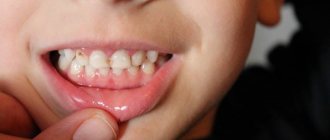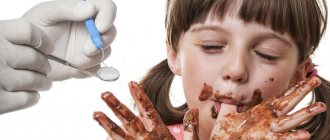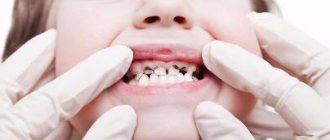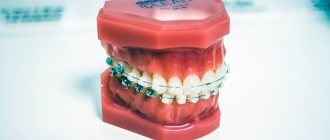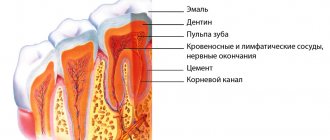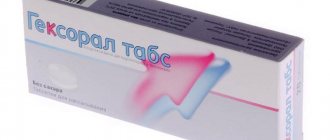Filling of baby teeth should be done in a timely manner to prevent tooth loss.
There is an opinion that baby teeth do not need to be treated, they should be removed immediately. But this is completely misleading. Early removal leads to jaw deformation and incorrect inclination of baby teeth. The permanent bone tissue that appears on the surface will lack a “supporting wall.” After removal, problems with bite formation may occur. And this, in turn, can cause more serious pathologies of the gastrointestinal tract.
But some parents firmly believe that even if, for example, caries is present, nothing bad will happen. When the baby tooth falls out, the problem will solve itself. It is not right. We must not forget that caries is caused by an infection that can migrate throughout the body. In childhood, especially when certain vaccinations are missing, this can cause meningitis, polio, sinusitis, chronic tonsillitis, tonsillitis, and bronchitis.
Filling at an early age will help the bite, speech, normal chewing function to form correctly, and maxillofacial deformities will not develop.
The most common dental problem in childhood is caries; it can occur as early as the first year of life. According to statistics, 13% of children under one year of age have caries. At the age of 6, 78% are already diagnosed with pathology of primary teeth.
And dentistry can be fun: bright colored fillings for the youngest patients
Colored fillings for children have become a real breakthrough in dentistry. Today, many modern dental clinics offer this type of filling. The popularity of such multi-colored fillings is quite understandable, because this is one of the few guaranteed ways to attract the attention of a child and relieve him of groundless fears about dental treatment. Often, this is the only opportunity to force a restless baby to sit in a chair and wait for the doctor to leave a bright spot on the tooth, which can then be shown to friends. Such cheerful multi-colored fillings for little patients will be discussed further in this article.
Contents and release form
One Twinkie Star set consists of:
- 40 capsules of 0.25 grams of material (5 capsules per color);
- coloring system (with the help of which the child will choose the color he likes from the eight presented);
- dispenser caps (special applicator in the form of a gun for quick and convenient application of the material).
The Twinkie Star Flow (flowable composite) set includes two NDT syringe dispensers in blue and pink and disposable application cannulas.
Non-Dripping Technology (NDT) - an innovative dispenser developed by VOCO, allows you to economically and safely apply the material without leaking or dripping.
The filling set of capsules provides eight color schemes for future fillings:
- gold;
- silver;
- blue;
- green;
- pink;
- orange;
- yellow;
- blackberry
Why treat baby teeth if they are going to fall out anyway?
Many parents mistakenly believe that caries and other diseases of baby teeth do not need such close attention, because the teeth will eventually be replaced by permanent ones. In fact, a temporary tooth affected by carious processes becomes an open source for the spread of infection. If the disease is given the opportunity to progress, it will not be limited to just one tooth, but will quickly spread to neighboring ones and will definitely reach the rudiments of permanent teeth. As a result, the child may have serious dental problems in the future. All this suggests that baby teeth are not only possible, but absolutely necessary to be treated, and this should be done when the first signs of a problem appear.
If left untreated, baby teeth can lead to problems with permanent teeth.
If we are talking about the rapid development of caries, then the most common method of treating the pathology is filling. Many mothers and fathers are perplexed why children are given fillings on teeth that will sooner or later fall out. The anxiety of parents is understandable, because they simply do not want to expose their children to unnecessary stress associated with the frightening buzzing of a drill, which they themselves have been afraid of since childhood. But treatment of children’s primary teeth is a prerequisite for the health of permanent ones, and several good reasons can be given for this:
- the roots of baby teeth are in direct contact with the rudiments of permanent teeth. Thus, any even minor problem with a temporary tooth will inevitably affect the condition of the permanent tooth and can even lead to the development of pulpitis,
- if you lose a baby tooth too early, it will certainly affect the state of the bite, may create some difficulties for the eruption of permanent units and even cause a change in the shape of the face,
- also, early loss of primary teeth can provoke certain speech defects,
- the lack of timely treatment for the development of caries can open access to infectious contamination of the body,
- If there is a need for orthodontic treatment, the teeth will still have to be healed, since one of the strict conditions for the installation of any corrective apparatus is the absence of open carious cavities and other dental diseases.
If there is a need for dental treatment, and we are talking about a child, it is important to take a responsible approach to finding a clinic and choosing a pediatric specialist. Treatment methods for primary teeth have their own characteristics and nuances, and only an experienced, qualified dentist will be able to choose the best solution to the existing problem.
Choose only experienced doctors to treat children's teeth
Advantages and disadvantages
VOCO's research and development is not limited to creating dental materials that are effective for patients.
Over the years, patented forms and systems have also been successfully developed for the quality, convenience and speed of the dentist's work.
Twinky Star has a number of advantages:
- the bright colors of the material will help the child push the feeling of fear into the background;
- quick filling process due to the capsule dispenser;
- presence of anticaries effect;
- it is possible not to use etching, thanks to the unique self-etching bonding from VOCO;
- high quality of the material due to physical and chemical parameters;
- the ability to treat complex clinical cases using a fluid form of the material;
- high biocompatibility with dental tissues.
The only disadvantage is the cost of treatment. Compared to cements or composites, the price will be higher.
Multi-colored fillings – both children are delighted and parents are calm
Gone are the days when the dental chair was associated with the terrifying sounds of a working drill, children's tears and screams. Today, dentistry is looking for and finding more effective, safe and completely painless methods of treating dental diseases, as well as ways to interest young patients and help them cope with their fears. Children's multi-colored fillings are an excellent opportunity to attract the baby's attention, arouse his interest and ensure that he sits quietly in the chair until the end of treatment, because he will also be curious to look at the result. Such fillings are created from a material such as compomer - a combination of glass ionomer cement and a hybrid composite1. Just look at the photo below - how interesting they look on children's teeth.
This is what fillings on a child’s teeth look like
“Yes, I myself am delighted with these colored fillings! Well, that's where the cuteness is! My daughter was diagnosed when she was 3 years old and it turned out to be such a cute pink spot on her tooth. It's been three years now and it's holding up great. But recently a hole appeared on another tooth, but since we had already moved to another city by that time, we had to look for a new clinic. This time we chose bright green and glitter. It also holds up great. Eh, if this had happened in my childhood, I wouldn’t have left the dentist.”
Milana_1984, Nizhny Novgorod, from correspondence on the woman.ru forum
So, let's look at the undeniable advantages of children's multi-colored fillings and why they are so popular today:
- fluoride content: this substance makes the enamel of children's teeth stronger and more durable. Thus, the filling also has a therapeutic effect,
- long service life: the strength and reliability of the installed filling is due to the tightness of its adherence to the dental tissues, and all thanks to glass ionomers and other composites included in the material. The service life of such colored fillings is on average 3 years,
- rapid hardening: the filling hardens under the influence of an ultraviolet lamp, and the filling process itself takes very little time. In addition, the composition is placed into the tooth cavity immediately from the capsule, and, accordingly, it does not require any preliminary preparation,
- relatively low cost,
- awakening the baby’s interest in oral care and daily brushing of teeth,
- the ability to promptly notice that the filling has begun to wear off due to its bright color,
- eliminating fear of dental treatment.
Currently, pediatric dentistry offers a variety of colors to choose from: pink, blue, green, yellow, orange, silver and gold, with or without sparkles. All colors are bright and rich. According to reviews, girls usually choose pink and yellow fillings, while boys prefer blue and green fillings.
The ability to choose your own color attracts the child's attention
Reviews
Ivan, 45 years old
If I had had colored fillings when I was a child, I don't think I would have been so afraid of dental procedures. I remember running away from my mother so as not to go to the dentist. It was very scary.
Larisa, 32 years old
My son got a colored filling a year ago. It holds up great. When the doctor showed him a palette of colors and told him what his tooth could look like after treatment, the son enthusiastically began choosing a color. Stopped on green. During the treatment I never made a peep. At home he showed off his green tooth to everyone and was very proud.
Alisa, 29 years old
We had two experiences installing colored fillings. One was placed on my daughter when she was 3 years old. A small pink spot appeared on the tooth and has been holding on well for three years now. Then we moved and had to go to another dentist in another clinic for the second tooth. They put in an orange filling with glitter. It fell out after a year. Either it was the sparkles, or the doctor was like that, in general, the second experiment turned out to be unsuccessful.
How is filling done?
Treatment with the installation of a colored filling can be divided into several stages. Let's take a closer look at this simple process. So, filling includes the following steps:
- anesthesia - for this purpose, the doctor can give an injection of an anesthetic or, for example, offer an inhalation method of administering an anesthetic,
- after this, the specialist clears the cavity from damaged tissue, for which a drill, laser or sandblasting is usually used,
- then the doctor evaluates the condition of the pulp. If the neurovascular bundle is not damaged, it is disinfected. In the same case, if the pulp is inflamed, the doctor will have to remove it,
- making sure that caries is completely eliminated and the cavity is cleared of bacteria, the dentist protects the nerve with a special gasket,
- filling - the cavity is filled layer by layer with material, which is then exposed to ultraviolet radiation and hardens. After this, the treated tooth is polished and ground.
The photo shows the process of exposure to ultraviolet light on a filling.
In order to eliminate, if possible, factors that can provoke the development of caries in a child, you should carefully monitor what he eats. Try to exclude sweets from his daily diet, since sugar becomes the main cause of tooth decay in childhood. It is equally important to teach your child to brush their teeth every day, and this needs to be done correctly. A pediatric dentist can teach you proper techniques for cleaning enamel from plaque and deposits during a routine examination. If you do not want to subject your child to dental treatment, even with such bright and cheerful fillings, carefully monitor the condition of his mouth and teeth, and also do not forget to show your child to a specialist 3-4 times a year.
- Batyukov N.M., Ivanova G.G., Kurganova I.M. Comparative assessment of the effectiveness of methods of treatment and filling of root canals using modern technologies, 2007.
Prevention of childhood caries
Let's consider preventive measures against dental diseases in children:
- Prevention of caries should begin while the baby is in the womb. To do this, the mother should take tablets containing calcium and fluoride.
- After birth, you need to monitor your oral hygiene. It is not recommended to lick a baby's spoon and pacifier, as harmful bacteria can pass from the adult to the baby.
- The child's nutrition must be correct. Consumption of fish and dairy products is important. Fluoride, found in some foods and also in toothpaste, is very important because it strengthens tooth enamel.
- You need to monitor the amount of sweets your child consumes and reduce it. Because they contribute to tooth decay. It is better to offer your baby treats containing xylitol, which replaces sugar.
- It is important to teach your child to brush their teeth thoroughly, choose the right toothpaste and change their brush in a timely manner.
- Regular visits to the dentist (every six months) are very important for disease prevention.
How much does a light seal cost?
Prices for dental work in reliable clinics are based on how complicated (or neglected) the tooth is. The cost of a light filling also depends on the condition of the tooth - the depth of the carious cavity, the degree of destruction of the walls, and the health of the canals. The more work the dentist requires, the higher the price will be. But the financial side of the issue may depend not only on the illness that the patient brought with him. If the clinic has a high status and brilliant authority, the price for a light filling may be too high. This is how reputable clinics maintain their status. Conversely, if a dental office has opened recently, and its main task is to attract customers, the price tags for services may be low.
In general, the cost of a light-curing filling ranges from 2,000 to 15,000 rubles. But higher prices are also possible (as a rule, in cases where the tooth is too neglected). Filling the front teeth is always more expensive than the back teeth, because the smile area requires the highest quality and most expensive materials. The variety of dental clinics today is too great to not know where to go. Each patient decides for himself what to choose: either too expensive treatment, but with a guarantee of quality, or hope for a successful result and significant savings. There is a third option: price and quality in equal proportions - you need to choose this one. As a rule, many patients rely on reviews from friends and acquaintances, and on this basis they choose a clinic and a dentist. The most important thing is not to forget that a healthy smile is priceless.
Dental treatment under anesthesia
General anesthesia is an effective way to make the treatment process as comfortable as possible. The child simply falls asleep and wakes up with healthy teeth. Thanks to this, the next time he will not feel afraid before visiting the dental office.
Dental filling for children under anesthesia is preferable in the following situations:
- treatment will last more than an hour;
- it is assumed that the procedure will be painful (when treating distant teeth or advanced caries);
- you need to fill several teeth at a time;
- local anesthesia is not possible (for example, due to allergies);
- it is not possible to place a filling on the child, since any actions in the oral cavity cause a gag reflex;
- unable to overcome panic fear of treatment.
The Natadent dental clinic employs qualified anesthesiologists who will calculate the dose of the drug with maximum accuracy. Thanks to this, the child will wake up immediately after the procedure, and drowsiness will pass very quickly. Modern drugs are completely safe and are used in the treatment of children over 3 years old, so any worries about the consequences are unnecessary.
Which ones are better?
To decide which filling is best to place on baby teeth, you should take into account their location. Photopolymer fillings are characterized by high aesthetics, so they can be used to fill teeth included in the smile area.
They are recommended to be installed if the child is able to calmly tolerate tooth cleaning (treatment) and is not afraid of subsequent manipulations by the dentist.
Colored fillings are in great demand due to the fact that they are interesting to children and provide psychological comfort. For parents, their advantage is that by the change in shade they understand that it is time to visit the dental office.
Instructions for use
The smaller the layer of applied material, the less shrinkage of the filling. If there is a large cavity, it is necessary to carry out application.
For every 2 mm of applied material, photopolymer particles are activated. On average, the exposure of light rays of each layer is 40 seconds.
The kit should be stored in a cool place between 4°-23°C for no more than two years. Warm to room temperature before use.
Preparation
Preliminary preparation for the upcoming filling of the cavity with a filling compound includes the following sequential actions of a specialist:
- cleaning the tooth with a special paste that does not contain fluoride compounds;
- isolation of the working area from adjacent units and the oral cavity;
- choosing a color scheme, as a rule, children actively and happily take part in this process;
- cavity preparation - here the technique of minimally invasive preparation is strictly followed, so that as many healthy, surrounding tissue fragments are preserved as possible;
- cleaning - carefully but thoroughly wash out all residues from the cavity with a stream of water, trying to completely eliminate its contact with blood and salivary fluid.
Excess moisture is removed with dry, warm air of targeted targeted action. A properly prepared area should be slightly damp; - protection of pulp tissue - this manipulation will be required only if the pulp is atypically close; in other clinical situations, padding is not required;
- adhesive - the procedure is performed sequentially and strictly layer by layer with an interval of 40 seconds. This time is quite enough for polymerization. For high-quality setting of the component, standard polymerization devices are used.
The final step is processing and polishing the surface, after which final fluoridation is performed along the edges of the filling, or the entire organ is coated with the product.
What anesthesia is used?
Baby teeth, like molars, have nerves, so they can hurt. During treatment, different types of anesthesia are used (according to the depth of tissue damage). There are three types of anesthesia, including:
- applique. It is a spray or gel that reduces sensitivity only on the surface of the oral mucosa. Application anesthesia is harmless and completely safe for the child’s body. It is often resorted to before removing a moving molar. For the treatment of caries or pulpitis, topical anesthesia is not enough;
- infiltration The technique involves an injection that blocks the nerve endings of the desired area. The new generation of drugs act instantly; after 2-3 minutes the doctor begins to treat caries, pulpitis or remove a fixed molar. During manipulations, the child is not tormented by painful sensations;
- conductor. This is the most powerful type of pain relief. It affects the nerve branch of a large area. Conduction anesthesia is used in rare cases when infiltration anesthesia is not enough (for example, if it is necessary to treat several teeth at once).
In pediatric dentistry, products based on articaine hydrochloride are used as an anesthetic.
In pediatric dentistry, products based on articaine hydrochloride are used for local anesthesia. The active substance has pronounced analgesic properties, but is non-toxic.
It rarely causes an allergic reaction and remains in the body for a short time. It is allowed to be used by children over 4 years of age.
Pediatric dentistry in Perm SC “Apollonia”: fissure sealing
Fissures
- these are folds and depressions on the surface of the enamel. Each person has a different fissure pattern, but plaque tends to get stuck in the folds of tooth enamel.
Pediatric dentistry is rich in various prevention methods. The method of fissure sealing is especially important during the period of change from primary to permanent occlusion.
Microorganisms in the oral cavity, processing plaque, form acid that corrodes the tooth. This is how caries occurs. This can be avoided by sealing the fissures. It is very important to carry out such a procedure in the early stages after tooth eruption, since during this period the enamel is poorly mineralized and, therefore, more susceptible to caries. The sealant mechanically protects the tooth enamel and chemically strengthens the enamel structure by releasing fluoride.
